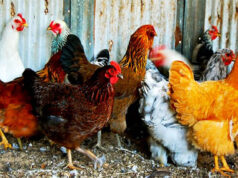Green muscle disease, also known as deep pectoral myopathy, is a condition affecting the poultry industry, particularly in broiler chickens. Understanding the green muscle disease chicken causes is crucial for poultry enthusiasts and farmers alike. This condition not only affects the health of chickens but also poses economic challenges. Let’s delve deeper into the causes, symptoms, and preventive measures associated with this disease.

What is Green Muscle Disease?
Green muscle disease is a degenerative condition affecting the deep pectoral muscles of chickens. It manifests as a greenish discoloration in the affected muscle tissue, leading to its name. This condition is often seen in broiler chickens, which are bred for their rapid growth and high meat yield.

The Main Causes of Green Muscle Disease in Chickens
Understanding the green muscle disease chicken causes involves identifying various factors that contribute to its onset. These factors include:
Rapid Growth Rates
Modern broiler chickens are bred for maximum growth in the shortest time possible. This rapid growth can lead to various health issues, including green muscle disease. The fast growth rate puts a strain on the chicken’s muscles, particularly the deep pectoral muscle.
Physical Activity
Contrary to what one might think, high levels of physical activity can contribute to green muscle disease. When chickens flap their wings excessively, it can cause damage to the deep pectoral muscles, leading to the development of the disease.
Stress Factors
Stress plays a significant role in the development of green muscle disease. Factors such as overcrowding, poor nutrition, and inadequate living conditions can induce stress in chickens, making them more susceptible to this condition.

Identifying Symptoms of Green Muscle Disease
Recognizing the symptoms of green muscle disease early on can help farmers take timely action. Here are some common signs:
Greenish Discoloration
The most obvious symptom is the greenish discoloration of the deep pectoral muscles. This is usually discovered during the processing stage.
Reduced Movement
Chickens with green muscle disease may exhibit reduced movement or reluctance to move, owing to muscle pain and discomfort.
Weight Loss
Affected chickens may experience weight loss or poor weight gain, impacting their overall growth and health.

Preventive Measures for Green Muscle Disease
Preventing green muscle disease requires a multifaceted approach. Here are some effective strategies:
Optimizing Growth Rates
One of the key strategies is to optimize the growth rates of broiler chickens. This can be achieved through selective breeding and proper nutritional management. Ensuring that chickens grow at a healthy and sustainable rate can minimize the risk of muscle overstrain.
Managing Physical Activity
While physical activity is essential for chickens’ well-being, it should be carefully managed. Avoiding excessive wing flapping and providing adequate space for movement can help reduce the risk of green muscle disease.
Reducing Stress
Addressing stress factors is crucial in preventing green muscle disease. Providing a conducive living environment, proper nutrition, and minimizing overcrowding can go a long way in reducing stress and preventing this condition.
The Economic Impact of Green Muscle Disease
Green muscle disease not only affects the health of chickens but also has significant economic implications. Farmers may face financial losses due to decreased meat quality and reduced market value of affected birds. Implementing preventive measures and ensuring early detection can help mitigate these economic challenges.
FAQs about Green Muscle Disease in Chickens
1. Is green muscle disease contagious?
No, green muscle disease is not contagious. It is a degenerative condition primarily caused by physical and environmental factors.
2. Can green muscle disease be treated?
There is no specific treatment for green muscle disease once it develops. Preventive measures and early detection are the best approaches to managing this condition.
3. How can I improve the living conditions of my chickens?
Improving living conditions involves providing adequate space, proper nutrition, and minimizing stress factors such as overcrowding. Regular health checks and maintaining a clean environment are also essential.
For more detailed information on chicken health and management, click here.
For an extensive breed directory of chickens, you can visit here.
As an Amazon Associate, I earn from qualifying purchases.










